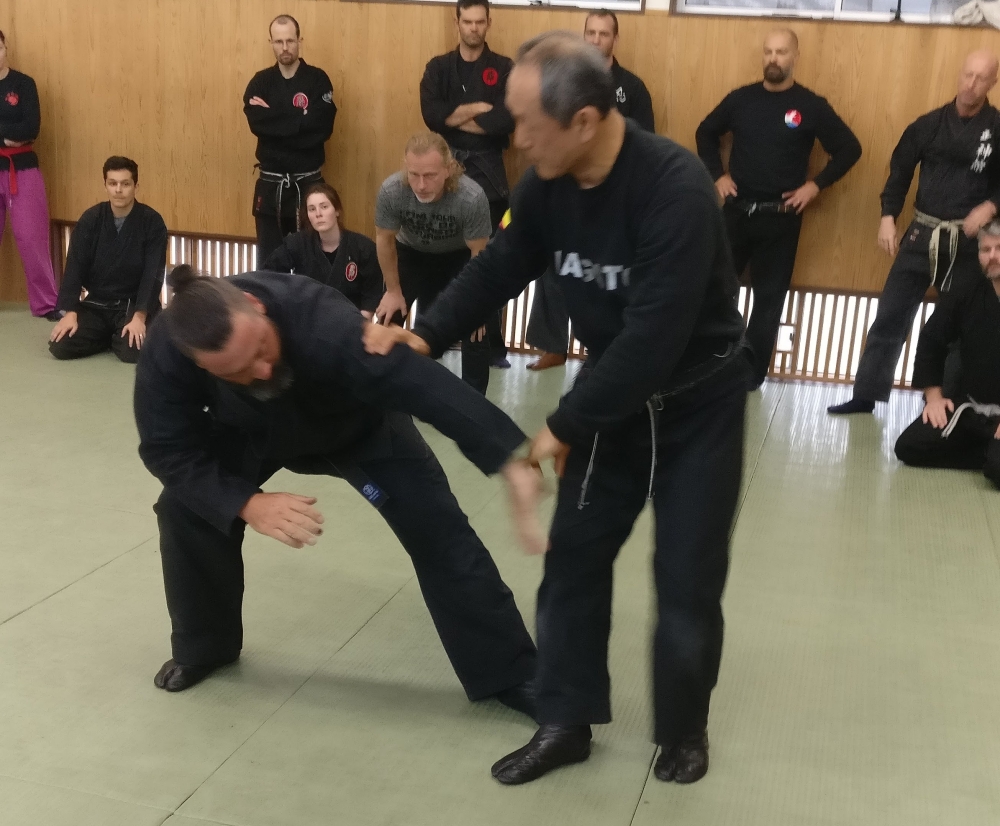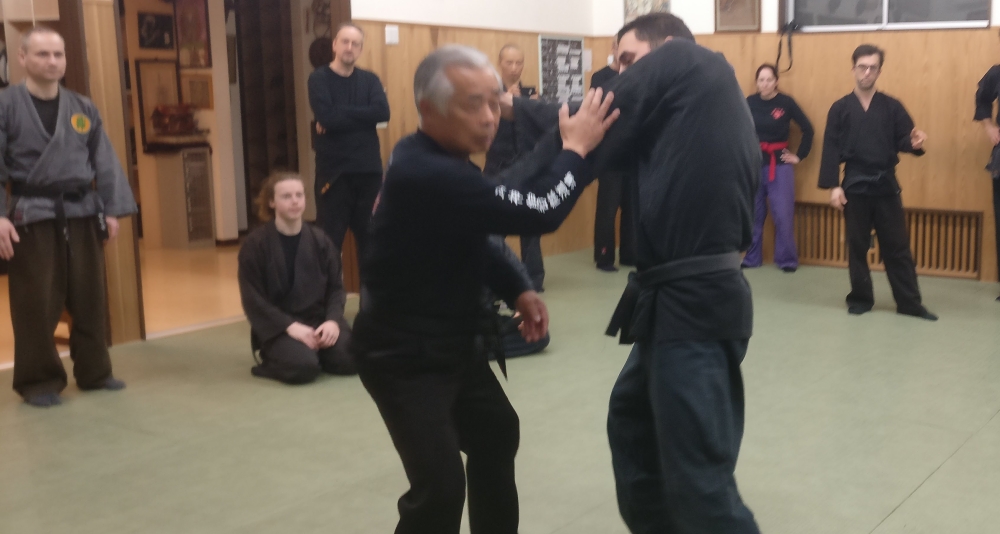From Shiro Kuma by kumafr

and so are you!
During training, Hatsumi Sensei spoke of “Ningen Kûkan Tsunagaru.” There is a connection between Humanity and Kūkan. (1)
He told us to “let the divine express itself through us.” Some of you might react to the word “divine,” but understand it as the Shintō or Taoist meaning of “Nature.” This “divine nature” is the Dōkyō, the Japanese for Taoism.
We express nature through our body because humans and emptiness are of the same quality. Science explains it in more acceptable terms. “About 99 percent of your body is made up of atoms of hydrogen, carbon, nitrogen, and oxygen. You also contain much smaller amounts of the other elements that are essential for life. Most of the cells in your body regenerate every seven to 15 years. Many of the particles that make up those cells have existed for millions of millennia. The hydrogen atoms in you were produced in the big bang. And the carbon, nitrogen, and oxygen atoms were made in burning stars. The weighty elements in you were made in exploding stars.” (3)
That means that we are empty by nature. If we concentrate all the matter that makes us, we would be very tiny. “If the nucleus were the size of a peanut, the atom would be about the size of a baseball stadium. If we lost all the dead space inside our atoms, we would each be able to fit into a particle of dust. And the entire human species would fit into the volume of a sugar cube.” (4)
Our body is not different from the stars in the universe. We are of the same nature. For that reason, the Kûkan inside of us is like the Kûkan of space. When we accept this, we understand that humanity and Kûkan are connected. We can control the attacker because he and we are part of the same universe, composed of the same elements.
“Kagenmi,” past, present, and future (5) do not exist. Everything happens at the same time. “Time itself doesn’t exist,” Sensei said during class.
When Uke attacks, we can control him as there is no difference between him, us, the universe. To express it, Sensei used the words “Kako, Genzai, Mirai.” (6) It gives a deeper meaning to the Kagenmi. It reads “the past is gone, the present exists, and the future is next.” In a fight, everything happens at the same moment. What is gone, what exists and what comes next are intertwined. They are one because Time as we see it doesn’t exist in reality.
Shintō expresses as “Nakaima.” (7) I prefer Nakaima to the Zen concept of “here and now” as it shows the impermanence of the moment. When you attack Hatsumi Sensei, this is how you feel. He uses only one finger to control you. And he uses it as a Shiten (8), a fulcrum, suspending you in time and space. With this one finger as a fulcrum, Uke is like supported weightlessly in mid-air.
Many of his Uke say that Sensei moves before the actual attack. That is a superior Yûgen (9) because when Uke sees what happens, he cannot alter his course of action. Sensei’s timing and distance are always perfect; his opponents are lost in indecision. What they see is so beautiful that they can only watch it, unfolding in front of their eyes, and die. It is like sliding on the ice. There is nothing you can do to prevent the crash. You can only watch it happen.
We lose the fight before the attack because we think, instead of adapting to the situation. That is how Sensei controls us so quickly. Because we trust our senses, we do not comprehend that we too are part of the universe. To copy Descartes, we could say “I think. Therefore I am defeated!”.
Each Human is part of the universe. The space within us vibrates with the space around us. We are all and nothing at the same time. The true essence of Mutō Dori is about control, and thinking is not the way to go.
We are the universe!
____________________
1. 人間空間繋, Ningen Kûkan Tsunagaru: a human being; person; man; mankind; humankind + space; room; airspace + to be tied together; to be connected to; to be linked to.
2. 道教, Dōkyō: Taoism is a philosophical and religious tradition that emphasizes living in harmony with the Tao. The term Tao (or Dao, depending on the romanization system used) originally means “way,” “path” or “principle,” and can be found in Chinese philosophies and religions other than Taoism. In Taoism, however, Tao denotes a metaphysical force which is ultimately ineffable: “The Tao that can be told is not the eternal Tao.”
3. https://www.symmetrymagazine.org/article/the-particle-physics-of-you
4. https://www.sciencealert.com/99-9999999-of-your-body-is-empty-space
5. 過現未, Kagenmi: past, present, and future; three temporal states of existence
6. 過去現在未来, Kako, Genzai, Mirai: past, present and future
7. 中今, Nakaima: the present, the middle of now (esp. as a privileged moment in eternity)
8. 支点, Shiten: fulcrum
9. 幽玄, Yûgen: subtle grace; hidden beauty; mysterious profundity; elegant simplicity; the subtle and profound. That was the theme we studied in 2004. We learned to move slightly ahead of Uke. At the exact moment, Uke takes his decision but has not moved yet.
REGISTRATION TO PARIS TAIKAI 13th-15th OF JULY 2018…
Read More What I like when training with Nagato sensei, is that he often has his way to convey his ideas. Today was no different when he said “protect your holes!” and laughed.
What I like when training with Nagato sensei, is that he often has his way to convey his ideas. Today was no different when he said “protect your holes!” and laughed.

 These days, this is precisely the feeling I have when training at the Honbu. When skydiving in free fall, you have this incredible feeling of falling within your fall. It is like being into a vortex. The fall seems infinite like falling into an endless fractal. If you had the chance to experience it, you know what I mean. Speed keeps increasing. And you feel you are falling inside your fall until you reach terminal velocity.
These days, this is precisely the feeling I have when training at the Honbu. When skydiving in free fall, you have this incredible feeling of falling within your fall. It is like being into a vortex. The fall seems infinite like falling into an endless fractal. If you had the chance to experience it, you know what I mean. Speed keeps increasing. And you feel you are falling inside your fall until you reach terminal velocity.